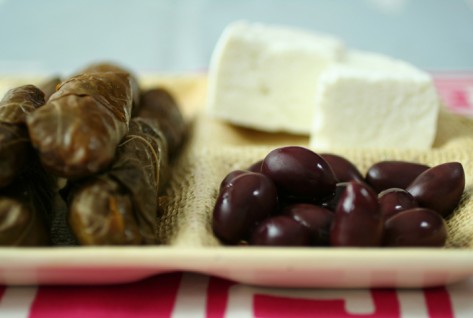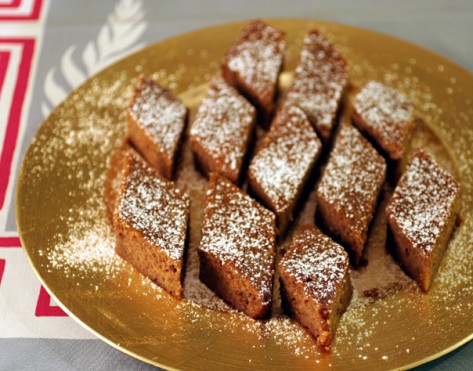A Greek Potluck for Three and Solving a Spoon Sweet Mystery

Stuffed grape leaves—vegetarian and meat-filled—and homemade feta, prepared by me, and Kalamata olives
Last week, Georgia, Judy, and I gathered for the second DCCC potluck, a delicious smorgasbord of Greek foods, all prepared from the DCCC pick The Food and Wine of Greeceby Diane Kochilas. Though we were only three—damn that Superbowl and winter colds—we had all of the major parts of a Greek meal covered—from meze to main course and dessert, including libations. (Greeks tend to enjoy foods we associate with dessert, like cakes and pastries, on their own, in the afternoon, rather than directly after a meal; but since we’re Americans, we had not one but three dessert options.) We enjoyed Metaxa brandy neat and as the star ingredient in a Metaxa Sour cocktail, very smooth ouzo from the Greek island of Lesbos, also called Mytilene, an island famed for the quality of its ouzo, and a refreshing, dry white wine from Spata, a town nearby Athens.

Fava, a dip made with yellow split peas, chips for dipping, and sautéed Greek sausage, prepared by Georgia

Rich Walnut Torte, prepared by Judy
Everything was delicious, but the highlight for me were the stuffed grape leaves—the meat-filled version served hot with Greek-style plain yogurt and the vegetarian ones (Rice-Stuffed Grape Leaves) served cold—and the Rich Walnut Cake and Fig Spoon Sweet made by Judy.
The walnut cake is a very rich, dense case that is saturated with a honey-sugar syrup spiced with clove and brightened with lemon juice. The cake itself is made mostly of ground walnuts with a small amount of flour and crushed Zwieback biscuits, and is flavored with cinnamon, ground clove, and grated orange rind. Judy substituted ground graham crackers for the Zwieback biscuits, which she could not find. She said the cake was easy to make, and the directions for it clear and full-proof. (Note: Judy could not find Zwieback biscuits, so she substituted Portuguese sweetbread that she had toasted and then chopped until finely ground in a food processor—a substitution recommended by the chef at her local food co-op.)
The Fig Spoon Sweet, made with dried figs, is a simple, sweet treat that highlights the flavor of the figs. The addition of brandy and lemon juice gives it just a touch of interest and keeps it from being one-dimensionally sweet.
While talking with Judy and Georgia about spoon sweets—what they are and how they’re served—I finally got them. The main ingredient—it is not always a fruit—it typically, but not always, left whole and simmered in a sugar syrup, often with fresh lemon juice added. In appearance, they are closer to what we might called “Stewed Fruit” or “Fruit Compote,” except that the ratio of sugar to water is much greater—closer to what we would use to make a fruit jam or preserve. Spoon sweets are not canned; the high amount of sugar helps to preserve them and, as Georgia said, they are not around long enough to worry about spoilage.
Author Diane Kochilas talks at some length in her introduction to Part IV, “The Sweets,” in The Food and Wine of Greece about the fascinating ritual of serving spoon sweets. Each guest is served a spoonful of a spoon sweet in the center of a small, ornamental plate. Cold water and sometimes a demitasse of thick, black Greek coffee accompany the sweet. And the timing is important. A certain amount of polite chatting must occur first. If a host serves a guest a sweet too quickly, it’s as though the guest is being rushed out the door; if too much time passes before it is served, it reflects badly on the host, as though she has been caught unprepared.
After reading Kochilas’s discussion, I still didn’t understand why spoon sweets, in particular, are served to guests in Greek homes. Georgia, a Greek-American, explained to me that it’s not that other types of sweets—such as a confection, pudding, pastry or cake—would not be served if available, it’s just that these types of sweets are made for special occasions and celebrations. They are not an everyday sweet. On the other hand, every Greek household always has a spoon sweet in the cupboard, ready for the unexpected guest.
All of a sudden I finally figured out that what I’d enjoyed some twenty-five years earlier in Istanbul, Turkey, at my college friend’s home, was, in fact, a spoon sweet. Mrs. Uzunhasan kept a large jar of whole strawberries in an abundant amount of sugar syrup at room temperature on top of her refrigerator. (Every morning the strawberries in syrup along with labne (a strained yogurt spread, similar to Greek yogurt but thicker), bread fresh from the neighborhood bakery, and delicious Turkish coffee were set out on the breakfast table. I would have to be dragged from the table to start each day of sightseeing.)
At the end of the evening, we three divvied up the leftovers; there were enough for all of us to enjoy Greek food for a couple of days. Upon seeing the amount of vegetarian grape leaves I had left over—the recipe makes about 4 dozen—Georgia urged me to try them warm with Avgolemono, the classic egg and lemon sauce that is used in many Greek dishes. I did. And would do it again.
